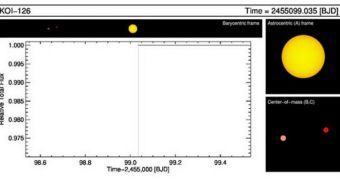The most recent observations conducted with NASA's planet-hunting telescope, Kepler, have revealed the existence of a triple star system whose members are orbiting each other in a type of stellar ballet.
According to the team that conducted the investigation, the stars sometimes align, as seen from Kepler's point of view, and this allows for some interesting science to be conducted.
The observatory was launched by the American space agency to search for signs of Earth-like, rocky exoplanets deep within the Milky Way, and it does so by looking for small variations in the brightness of stars in its field of view.
If such changes are detected, then they can only be produced by an object passing in between the telescope and its target. These objects may include comets, asteroids and exoplanets, experts say.
After Kepler discovers stars that exhibit peculiar behavior, it sends the data back to Earth, and larger telescopes are then used to scan those stars. If the presence of exoplanets is confirmed, then their existence is enlisted in catalogs, and observatories move on to other targets.
From time to time, the telescope finds interesting star systems, and the new one is no exception. Details of the cosmic formation, dubbed KOI-126 (A, (B, C)), were presented on January 11, at the 217th winter meeting of the American Astronomical Society (AAS 2011).
“More or less the entire system is edge-on from the perspective of Kepler. It's the first of its kind in that it's eclipsing amongst all three of the members,” says astronomer Joshua Carter, quoted by Space.
The expert holds an appointment at the Harvard-Smithsonian Center for Astrophysics (CfA), in Cambridge, Massachusetts, and he was also the lead scientist on the new investigation. Carter says that the system was first believed to be made up of a star and surrounding exoplanets.
Subsequent observations however revealed that the entire system was in fact a group of stars orbiting each other. Two of the three stars were established to be very small, at about 0.2 percent the mass of the Sun.
“They probe a regime in stellar mass that is not very well sampled by other data,” Carter explains. He adds that stars this small should theoretically be invisible to telescope, and says that more research is needed to establish how they develop.
Carter also adds that a triple star system can contain exoplanets as well. The chances of this happening are indeed slimmer, but planets can indeed evolve in such a system. Details of the new investigation will also be published in the January 14 issue of the top journal Science.

 14 DAY TRIAL //
14 DAY TRIAL //